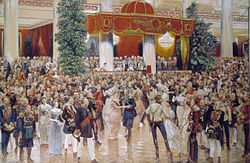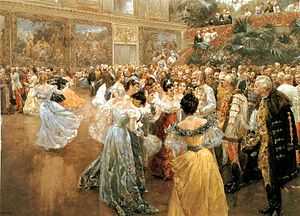Ball (dance party)



A ball is a formal dance party.
Attenders wear evening attire, which is specified on the invitation as black tie or white tie (the most formal). Social dance forms a large part of the evening; actual ballroom dancing may or may not occur.
Etymology
The word "ball" derives from the Latin word ballare, meaning "to dance"; the Latin word also developed into bailar, the Spanish and Portuguese verbs for "to dance". Catalan uses the same word, ball, for the dance event.
Types of ball
Example of a country ball in Georgian England
A well-documented ball occurred at Kingston Lacy, Dorset, England, on 19 December 1791. The occasion was to celebrate the completion of major alterations to the house and the event was organised by Frances Bankes, wife of Henry Bankes, owner of the house. The event involved 140 guests, with dancing from 9pm to 7am, interrupted by dinner at 1am.[1]
See also

References
- ↑ "Frances Bankes' ball at Kingston Lacy 19 December 1791 (From Regency History)". Regency History.net. Retrieved 2014-01-03.
Further reading
- Wallace, Carol McD. et al. (1986). Dance: a very social history. New York: The Metropolitan Museum of Art. ISBN 9780870994869.